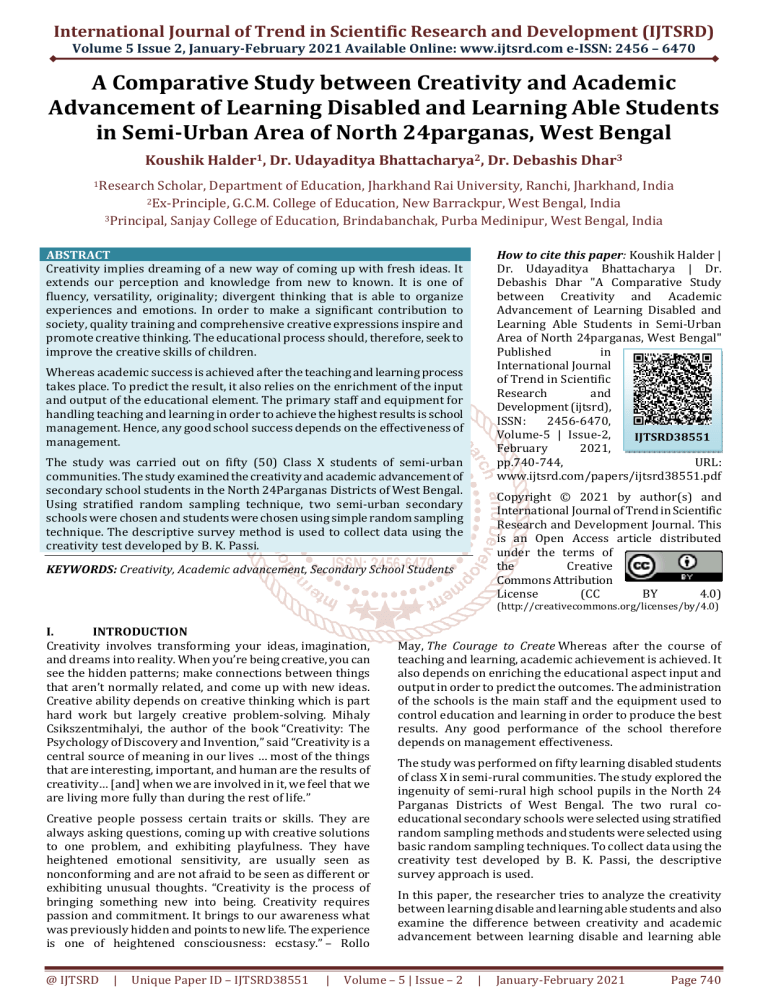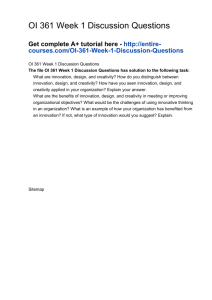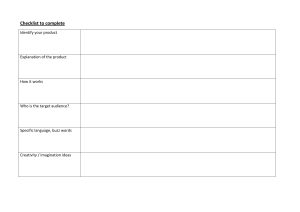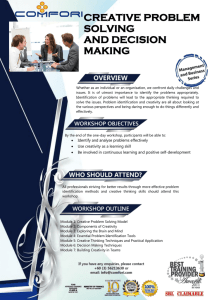
International Journal of Trend in Scientific Research and Development (IJTSRD)
Volume 5 Issue 2, January-February 2021 Available Online: www.ijtsrd.com e-ISSN: 2456 – 6470
A Comparative Study between Creativity and Academic
Advancement of Learning Disabled and Learning Able Students
in Semi-Urban Area of North 24parganas, West Bengal
Koushik Halder1, Dr. Udayaditya Bhattacharya2, Dr. Debashis Dhar3
1Research
Scholar, Department of Education, Jharkhand Rai University, Ranchi, Jharkhand, India
G.C.M. College of Education, New Barrackpur, West Bengal, India
3Principal, Sanjay College of Education, Brindabanchak, Purba Medinipur, West Bengal, India
2Ex-Principle,
ABSTRACT
Creativity implies dreaming of a new way of coming up with fresh ideas. It
extends our perception and knowledge from new to known. It is one of
fluency, versatility, originality; divergent thinking that is able to organize
experiences and emotions. In order to make a significant contribution to
society, quality training and comprehensive creative expressions inspire and
promote creative thinking. The educational process should, therefore, seek to
improve the creative skills of children.
How to cite this paper: Koushik Halder |
Dr. Udayaditya Bhattacharya | Dr.
Debashis Dhar "A Comparative Study
between Creativity and Academic
Advancement of Learning Disabled and
Learning Able Students in Semi-Urban
Area of North 24parganas, West Bengal"
Published
in
International Journal
of Trend in Scientific
Research
and
Development (ijtsrd),
ISSN:
2456-6470,
Volume-5 | Issue-2,
IJTSRD38551
February
2021,
pp.740-744,
URL:
www.ijtsrd.com/papers/ijtsrd38551.pdf
Whereas academic success is achieved after the teaching and learning process
takes place. To predict the result, it also relies on the enrichment of the input
and output of the educational element. The primary staff and equipment for
handling teaching and learning in order to achieve the highest results is school
management. Hence, any good school success depends on the effectiveness of
management.
The study was carried out on fifty (50) Class X students of semi-urban
communities. The study examined the creativity and academic advancement of
secondary school students in the North 24Parganas Districts of West Bengal.
Using stratified random sampling technique, two semi-urban secondary
schools were chosen and students were chosen using simple random sampling
technique. The descriptive survey method is used to collect data using the
creativity test developed by B. K. Passi.
Copyright © 2021 by author(s) and
International Journal of Trend in Scientific
Research and Development Journal. This
is an Open Access article distributed
under the terms of
the
Creative
Commons Attribution
License
(CC
BY
4.0)
KEYWORDS: Creativity, Academic advancement, Secondary School Students
(http://creativecommons.org/licenses/by/4.0)
I.
INTRODUCTION
Creativity involves transforming your ideas, imagination,
and dreams into reality. When you’re being creative, you can
see the hidden patterns; make connections between things
that aren’t normally related, and come up with new ideas.
Creative ability depends on creative thinking which is part
hard work but largely creative problem-solving. Mihaly
Csikszentmihalyi, the author of the book “Creativity: The
Psychology of Discovery and Invention,” said “Creativity is a
central source of meaning in our lives … most of the things
that are interesting, important, and human are the results of
creativity… [and] when we are involved in it, we feel that we
are living more fully than during the rest of life.”
Creative people possess certain traits or skills. They are
always asking questions, coming up with creative solutions
to one problem, and exhibiting playfulness. They have
heightened emotional sensitivity, are usually seen as
nonconforming and are not afraid to be seen as different or
exhibiting unusual thoughts. “Creativity is the process of
bringing something new into being. Creativity requires
passion and commitment. It brings to our awareness what
was previously hidden and points to new life. The experience
is one of heightened consciousness: ecstasy.” – Rollo
@ IJTSRD
|
Unique Paper ID – IJTSRD38551
|
May, The Courage to Create Whereas after the course of
teaching and learning, academic achievement is achieved. It
also depends on enriching the educational aspect input and
output in order to predict the outcomes. The administration
of the schools is the main staff and the equipment used to
control education and learning in order to produce the best
results. Any good performance of the school therefore
depends on management effectiveness.
The study was performed on fifty learning disabled students
of class X in semi-rural communities. The study explored the
ingenuity of semi-rural high school pupils in the North 24
Parganas Districts of West Bengal. The two rural coeducational secondary schools were selected using stratified
random sampling methods and students were selected using
basic random sampling techniques. To collect data using the
creativity test developed by B. K. Passi, the descriptive
survey approach is used.
In this paper, the researcher tries to analyze the creativity
between learning disable and learning able students and also
examine the difference between creativity and academic
advancement between learning disable and learning able
Volume – 5 | Issue – 2
|
January-February 2021
Page 740
International Journal of Trend in Scientific Research and Development (IJTSRD) @ www.ijtsrd.com eISSN: 2456-6470
students of secondary school students in semi-urban area of
North 24parganas district of West Bengal
II.
OBJECTIVES:
1. To study the significance of the mean differences in the
creativity of learning disable (25) and learning able (25)
students of secondary school (total sample=50) in semiurban area of North 24parganas district of West Bengal.
2.
To study the significance of the mean differences in the
academic advancement of learning disable (25) and
learning able (25) students of secondary school (total
sample=50) in semi-urban area of North 24parganas
district of West Bengal.
3.
To study the significance of the mean differences in the
creativity and academic advancement of learning disable
students of secondary school students (total sample=25)
in semi-urban area of North 24parganas district of West
Bengal.
4.
To study the significance of the mean differences in the
creativity and academic advancement of learning able
students of secondary school students (total sample=25)
in semi-urban area of North 24parganas district of West
Bengal.
III.
HYPOTHESIS:
H01: There exists no significant difference in the mean
scores in the creativity of learning disable (25) and learning
able (25) students of secondary school (total sample=50) in
semi-urban area of North 24parganas district of West
Bengal.
H02: There exists no significant difference in the mean
scores of academic advancement of learning disable (25) and
learning able (25) students of secondary school (total
sample=50) in semi-urban area of North 24parganas district
of West Bengal.
4.2.1 Sample selected for the study: Sample consists of
120 students selected from 2 schools of north 24 parganas
district, West Bengal. From the selected 120 students, the
investigator identified 50 (25 learning disabled and 25
learning able students) students.
4.2.1.1 Criteria and Tools/Techniques used for
identifying Learning Disabled students:
1. Achievement Test of learning disability developed by the
investigator was administered. Students scoring above
40% were eliminated. Others were selected (last 25
students).
2. Children deviation I.Q. limit below 90(Dull Average)
were selected.
3. Children who are absent frequently in school were
eliminated.
4. Children having sensorial handicaps were selected.
4.2.1.2 Criteria and Tools/Techniques used for
identifying Normal Students:
In the Achievement Test the students who came in 1st, 4rd,
7th, 10th ……were selected. This was continued till the
investigator got 25 normal students.
4.3
4.4
Variables: i) Achievement test, ii) Test of
Intelligence (MGTI-M), iii) Creativity test.
4.5
Tools:
1. Mixed Type Group Test of Intelligence (MGTI-M):
This test consists of two tests, i.e., verbal and non-verbal.
This test developed by Dr. P. N. Mehrotra. These tests
contain five sub-tests each. Under each test there are
fifty items organized in an omnibus selective form.
2.
Creativity test: This test also consists of two tests, i.e.,
verbal and non-verbal, developed by Dr. B. K. Passi is
used. This includes six sub-tests, i.e. (i) the seeing
problems test, (ii) the unusual tests, (iii) the
consequences test, (iv) the test of inquisitiveness, (v) the
square puzzle test, and (vi) the blocks test of creativity.
The first three tests are verbal and last three tests are
non-verbal in nature. (Non-verbal performance
materials are 19 Block of 1", 12 Block of ½”, 1 Wooden
Board, 5 Identical Right Angled triangles for Plastic and
5 Identical Quadrilaterals for Plastic). It measures three
components of creativity—fluency, flexibility, and
originality.
3.
Achievement test: This test prepared by the
Investigators. This includes 100 objective types question
which they have learned before.
H03: There exists no significant difference in the creativity
and academic advancement of learning disable students of
secondary school students (total sample=25) in semi-urban
area of North 24parganas district of West Bengal.
H04: There exists no significant difference in the creativity
and academic advancement of learning able students of
secondary school students (total sample=25) in semi-urban
area of North 24parganas district of West Bengal.
IV.
METHODOLOGY:
4.1
Population: Learning able and learning disable
Secondary school students of West Bengal Board of
Secondary Education who are studying in class X were
considered as population for this study.
4.2
Sample: Total number of students in the study was
fifty(50). 25 learning disabled and 25 learning able students
selected randomly from two semi-urban secondary schools
of North 24parganas district of West Bengal were chosen as
sample.
@ IJTSRD
|
Unique Paper ID – IJTSRD38551
|
Method: Descriptive approach is used of this study.
4.6
Techniques:
Statistical Analysis (Mean, SD, Std. Error, ‘t’ value and
graphical re-presentations are used.
4.7
Result and Interpretation of data:
In terms of mean, standard deviation, Std. Error and t-test
process, the collected data was evaluated via the abovementioned inventories.
Volume – 5 | Issue – 2
|
January-February 2021
Page 741
International Journal of Trend in Scientific Research and Development (IJTSRD) @ www.ijtsrd.com eISSN: 2456-6470
Table – 1 Creativity Score of All Students:
CN = Stands for Code Number of students,
CS= Stands for Creativity Score
Learning disabled
Learning able
Creativity Academic advancement Creativity Academic advancement
CN
CS
CN
CS
CN
CS
CN
CS
01
52
01
36
01
48
01
55
02
49
02
33
02
44
02
53
03
50
03
31
03
46
03
52
04
41
04
30
04
43
04
50
05
47
05
32
05
41
05
51
06
42
06
35
06
38
06
49
07
44
07
37
07
49
07
47
08
48
08
39
08
51
08
48
09
43
09
38
09
53
09
51
10
44
10
37
10
50
10
54
11
42
11
36
11
47
11
58
12
40
12
32
12
44
12
55
13
38
13
34
13
42
13
52
14
37
14
29
14
41
14
49
15
41
15
30
15
46
15
48
16
44
16
28
16
45
16
46
17
46
17
29
17
40
17
45
18
45
18
31
18
38
18
50
19
36
19
33
19
41
19
51
20
37
20
30
20
37
20
47
21
39
21
29
21
39
21
44
22
40
22
31
22
40
22
46
23
41
23
34
23
43
23
51
24
43
24
36
24
47
24
49
25
48
25
32
25
45
25
45
Table – 2 Showing the result of mean score, standard deviation, t-value and level of significance of the creativity of
learning disable (25) and learning able (25) students of secondary school (total sample=50) in semi-urban area of
North 24parganas district of West Bengal.
Groups
N Mean
SD Std. Error ‘t’ value Level of Significance
Learning disabled (creativity) 25 43.08 4.29
1.22
0.69
Not Significant
Learning able (creativity)
25 43.92 4.31
df = 48
Table value = 2.01 at 0.05 level
Interpretation
Table - 2 shows that the mean scores on creativity of learning disable and learning able students were 43.08 and 43.92 with
standard deviation of 4.29 and 4.31 respectively. When the t-test was applied to compare the mean scores of both the groups, it
was found that the calculated t-value 0.69 was less than the table value at 0.05 levels of significance. Thus, the difference
between the two means is statistically not significant.
Therefore, the hypothesis that there exists no significant difference in the mean scores of creativity between learning disable
(25) and learning able (25) students of secondary school students (total sample=50) in semi-urban area of North 24parganas
district of West Bengal is accepted.
Fig. 1 Mean differences in the creativity of learning disabled and learning able students of secondary school
students (total sample) in semi-urban area of North 24parganas district of West Bengal.
@ IJTSRD
|
Unique Paper ID – IJTSRD38551
|
Volume – 5 | Issue – 2
|
January-February 2021
Page 742
International Journal of Trend in Scientific Research and Development (IJTSRD) @ www.ijtsrd.com eISSN: 2456-6470
Table – 3 Showing the result of mean score, standard deviation, t-value and level of significance of academic
advancement of learning disable (25) and learning able (25) students of secondary school (total sample=50) in
semi-urban area of North 24parganas district of West Bengal.
Groups
N Mean
SD Std. Error ‘t’ value Level of Significance
Learning disable (academic advancement) 25 32.88 3.17
0.95
17.85
Significant
Learning able (academic advancement)
25 49.84 3.52
df = 48
Table value = 2.01 at .05 level
Interpretation
Table - 3 shows that the mean scores on academic advancement of learning disabled students (25) and learning able students
(25) students were 32.88 and 49.84 with standard deviation of 3.17 and 3.52 respectively. The ‘t’ value is 17.85 which is
greater than the table value at 0.05 levels of significance. Thus, the difference between the two means is statistically significant.
Therefore, the hypothesis that there exists no significant difference in the mean scores of academic advancement between
learning disabled (25) and learning able (25) students of secondary school students of North 24parganas district of West
Bengal is not accepted.
Fig. 2 Mean differences in the academic advancement of learning disabled and learning able students of secondary
school students (total sample) in semi-urban area of North 24parganas district of West Bengal.
Table – 4 Showing the result of Mean score, Standard deviation, t-value and level of significance of the creativity
and academic advancement of learning disabled students of secondary school students (total sample=25) in semiurban area of North 24parganas district of West Bengal.
Groups
N Mean
SD Std. Error ‘t’ value Level of Significance
Creativity (Learning disabled)
25 43.08 4.29
Not
1.07
9.53
Significant
Academic Advancement (Learning disabled) 25 32.88 3.17
df = 48
Table value = 2.01 at .05 level
Interpretation
Table - 4 shows that the mean scores on creativity and academic advancement of learning disabled students (25) were 43.08
and 32.88 with standard deviation of 4.29 and 3.17 respectively. The ‘t’ value is 9.53 which is greater than the table value at
0.05 levels of significance. Thus, the difference between the two means is statistically significant.
Therefore, the hypothesis that there exists no significant difference in the mean scores of creativity and academic advancement
of learning disabled students (25) students of secondary school students in semi-urban area of North 24parganas district of
West Bengal is not accepted.
Fig. 3 Mean differences in the creativity and academic advancement of learning disabled students of secondary
school students in semi-urban area of North 24parganas district of West Bengal.
@ IJTSRD
|
Unique Paper ID – IJTSRD38551
|
Volume – 5 | Issue – 2
|
January-February 2021
Page 743
International Journal of Trend in Scientific Research and Development (IJTSRD) @ www.ijtsrd.com eISSN: 2456-6470
Table – 5 Showing the result of Mean score, Standard deviation, t-value and level of significance of the creativity
and academic advancement of learning able students of secondary school students (total sample=25) in semiurban area of North 24parganas district of West Bengal.
Groups
N Mean
SD Std. Error ‘t’ value Level of Significance
Creativity (Learning able)
25 43.92 4.31
1.11
5.33
Significant
Academic Advancement (Learning able) 25 49.84 3.52
df = 48
Table value = 2.01 at .05 level
Interpretation
Table - 5 shows that the mean scores on creativity and academic advancement of learning able students (25) were 43.92 and
49.84 with standard deviation of 4.31 and 3.52 respectively. The ‘t’ value is 5.33 which is greater than the table value at 0.05
levels of significance. Thus, the difference between the two means is statistically significant.
Therefore, the hypothesis that there exists no significant difference in the mean scores of creativity and academic advancement
of learning able students (25) students of secondary school students in semi-urban area of North 24parganas district of West
Bengal is not accepted.
Fig. 4 Mean differences in the creativity and academic advancement of learning able students of secondary school
students in semi-urban area of North 24parganas district of West Bengal.
V.
FINDINGS OF THE STUDY:
From the Interpretation of the data which are represented
by different Tables and Figures, it is concluded that –
1. There exists no significant difference in the mean scores
of creativity of learning disable (25) and learning able
(25) students of secondary school (total sample=50) in
semi-urban area of North 24parganas district of West
Bengal.
2. There exists significant difference in the mean scores of
academic advancement of learning disable (25) and
learning able (25) students of secondary school (total
sample=50) in semi-urban area of North 24parganas
district of West Bengal.
3. There exists significant difference in the mean scores of
creativity and academic advancement of learning disable
students of secondary school students (total sample=25)
in semi-urban area of North 24parganas district of West
Bengal.
4. There exists significant difference in the mean scores of
creativity and academic advancement of learning able
students of secondary school students (total sample=25)
in semi-urban area of North 24parganas district of West
Bengal.
VI.
CONCLUSION:
Creative people possess certain traits or skills.
They are always
asking questions, coming up with creative solutions to one
problem, and exhibiting playfulness. They have heightened
emotional sensitivity, are usually seen as nonconforming and
are not afraid to be seen as different or exhibiting unusual
thoughts.
Creativity is a process in which something unique and
somehow useful is created. This improves our awareness
and experience from the familiar to the unfamiliar. They are
capable of arranging thoughts and feelings in a manner that
@ IJTSRD
|
Unique Paper ID – IJTSRD38551
|
is fluent, versatile and uniquely thoughtful. Quality teaching
and detailed artistic expressions encourage and foster
creative thought that contributes significantly to society. The
study was performed on twenty five (25) learning disable
and twenty five (25) learning able students of class X in
semi-urban communities. The study explored the ingenuity
of semi-urban high school pupils in the North 24 Parganas
Districts of West Bengal. To collect data using the creativity
test developed by B. K. Passi, the descriptive survey
approach is used.
From the outcomes it is found that there exists no significant
difference in creativity between learning disable and
learning able students but there exists significant difference
in creativity and academic advancement between learning
disable and learning able students of secondary school
students in semi-urban area of North 24parganas district of
West Bengal.
REFERENCES:
[1] Halder, K., Bhattacharya, U. (2020), A Study on Creativity
of Secondary School Students in North 24Parganas
Districts of West Bengal
[2] https://www.creativityatwork.com/2014/02/17/wh
at-is-creativity/
[3] https://en.wikipedia.org/wiki/Creativity
[4] Omari Omari Hemedi Makore, Hamidu Hamidu Saleh
Shukuru (2017), Academic Achievement of Students
not only Depends on the Process of Teaching and
Learning but also Effectiveness of Staff Management.
https://www.atlantispress.com/proceedings/coema17/25882343
[5] Mangal. S. K. (2012), Statistics in Psychology and
Education, 2nd Edition, PHI Learning Private Limited,
New Delhi – 110001.
Volume – 5 | Issue – 2
|
January-February 2021
Page 744




